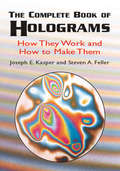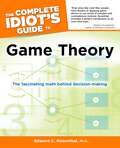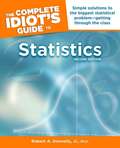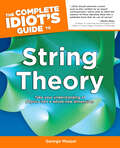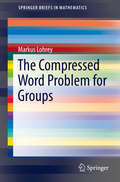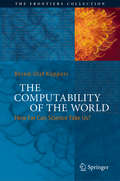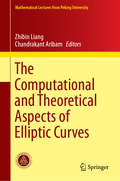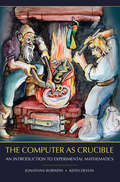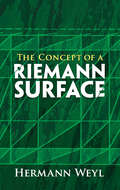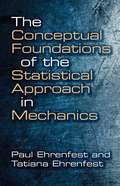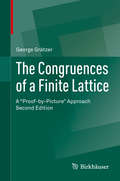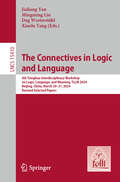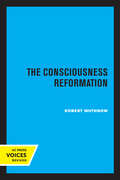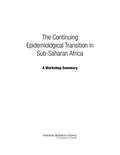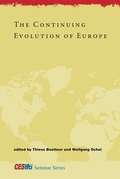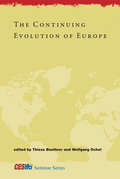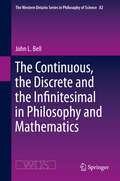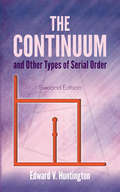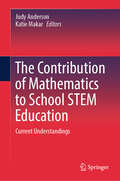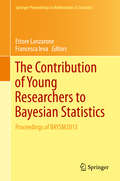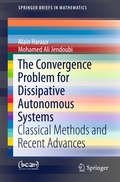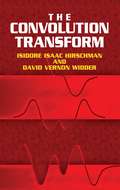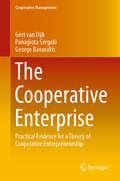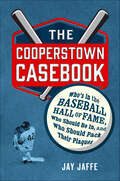- Table View
- List View
The Complete Book of Holograms: How They Work and How to Make Them
by Joseph E. Kasper Steven A. Feller"I predict that Kasper and Feller will become a standard reference on holography for students and interested laymen." -- James A. Van Allen.For most nonscientists, holograms are an intriguing -- if not mesmerizing -- mystery. How are these seemingly magical images created and what makes them appear to be three-dimensional? This fascinating book not only offers the answers to these and other questions about holography -- it even gives step-by-step instructions so that readers can manufacture their own holograms.Written in a lively, stimulating style, The Complete Book of Holograms provides a thorough, easy-to-understand explanation of the theory and science of making holograms. The physical basis of holography is introduced through a discussion of interference patterns in water waves and in light waves. Without complicated mathematics or physics, the authors explain the two models of holography -- the geometric and the more complex zone-plate model -- and the several different types of holograms, including transmission, reflection, phase, projection, rainbow, multiplex, and others. They explain how to copy holograms; describe special techniques and applications; and discuss potential uses for holography, including the use of holograms in movies, television, and data storage. They also present some basic setups for making holograms and show readers how to create their own -- using little more than simple photographic equipment and an inexpensive laser. Two appendixes give advice on laser safety and list sources of material and further information.
The Complete Idiot's Guide to Game Theory: The Fascinating Math Behind Decision-Making
by Edward C. RosenthalGain some insight into the game of life... Game Theory means rigorous strategic thinking. It is based on the idea that everyone acts competitively and in his own best interest. With the help of mathematical models, it is possible to anticipate the actions of others in nearly all life's enterprises. This book includes down-to-earth examples and solutions, as well as charts and illustrations designed to help teach the concept. In The Complete Idiot's Guide® to Game Theory, Dr. Edward C. Rosenthal makes it easy to understand game theory with insights into: • The history of the discipline made popular by John Nash, the mathematician dramatized in the film A Beautiful Mind • The role of social behavior and psychology in this amazing discipline • How important game theory has become in our society and why
The Complete Idiot's Guide to Statistics
by Robert DonnellyLike other science/math Complete Idiot's Guides, this book is aimed at high school and college students who need to take statistics to fulfill a degree requirement and follows a standard statistics curriculum. But because statistics is a mathematical topic taught to many non-mathematical people in a manner that often overwhelms them, the presentation of the material focuses on the concepts rather than the computations. Students learn the required math involved, but the focus is on interpreting final results as opposed to the details of the technique.
The Complete Idiot's Guide to String Theory: Take Your Understanding of Physics into a Whole New Dimension!
by George MusserWe&’re living in the midst of a scientific revolution that&’s captured the general public&’s attention and imagination. The aim of this new revolution is to develop a &“theory of everything&”—a set of laws of physics that will explain all that can be explained, ranging from the tiniest subatomic particle to the universe as a whole. Here, readers will learn the ideas behind the theories, and their effects upon our world, our civilization, and ourselves.The Complete Idiot&’s Guide® String Theory explains how this exciting idea holds up against competing theories. In this Complete Idiot&’s Guide®, you get:• Clear explanation of quantum mechanics, Einstein&’s theories of relativity, and how string theory unites them. • A quick, easy-to-understand overview of competing theories and how they might be tested.• Fast facts about black holes, what&’s inside them, how they&’re made, and why they&’re so paradoxical. • Simple, smart tips to help you visualize extra dimensions.
The Complete Idiot's Guide to Trigonometry: Master Trig with Crystal-Clear Explanations of All the Basics
by Dmitriy Fotiyev Izolda Fotiyeva• Follows a standard course curriculum • Includes both polar coordinates and complex numbers, unlike the competition
The Compressed Word Problem for Groups
by Markus LohreyThe Compressed Word Problem for Groups provides a detailed exposition of known results on the compressed word problem, emphasizing efficient algorithms for the compressed word problem in various groups The author presents the necessary background along with the most recent results on the compressed word problem to create a cohesive self-contained book accessible to computer scientists as well as mathematicians. Readers will quickly reach the frontier of current research which makes the book especially appealing for students looking for a currently active research topic at the intersection of group theory and computer science. The word problem introduced in 1910 by Max Dehn is one of the most important decision problems in group theory. For many groups, highly efficient algorithms for the word problem exist. In recent years, a new technique based on data compression for providing more efficient algorithms for word problems, has been developed, by representing long words over group generators in a compressed form using a straight-line program. Algorithmic techniques used for manipulating compressed words has shown that the compressed word problem can be solved in polynomial time for a large class of groups such as free groups, graph groups and nilpotent groups. These results have important implications for algorithmic questions related to automorphism groups.
The Computability of the World: How Far Can Science Take Us? (The Frontiers Collection)
by Bernd-Olaf Küppers Paul WoolleyIn this thought-provoking book Küppers, an internationally renowned physicist, philosopher and theoretical biologist, addresses a number of science's deepest questions: Can physics advance to the origin of all things and explain the unique phenomena of life, time and history? Are there unsolvable enigmas of the world? How did life originate? Is language a general phenomenon of Nature? What is time? Is it possible to express the history of the world in formulae? Where is science leading us? These and other provocative questions essential for a deeper understanding of the world are treated here in a refreshing and stimulating manner.
The Computational and Theoretical Aspects of Elliptic Curves (Mathematical Lectures from Peking University)
by Zhibin Liang Chandrakant AribamThis volume presents a collection of results related to the BSD conjecture, based on the first two India-China conferences on this topic. It provides an overview of the conjecture and a few special cases where the conjecture is proved. The broad theme of the two conferences was “Theoretical and Computational Aspects of the Birch and Swinnerton-Dyer Conjecture”. The first was held at Beijing International Centre for Mathematical Research (BICMR) in December 2014 and the second was held at the International Centre for Theoretical Sciences (ICTS), Bangalore, India in December 2016. Providing a broad overview of the subject, the book is a valuable resource for young researchers wishing to work in this area. The articles have an extensive list of references to enable diligent researchers to gain an idea of the current state of art on this conjecture.
The Computer as Crucible: An Introduction to Experimental Mathematics
by Jonathan Borwein Keith DevlinKeith Devlin and Jonathan Borwein, two well-known mathematicians with expertise in different mathematical specialties but with a common interest in experimentation in mathematics, have joined forces to create this introduction to experimental mathematics. They cover a variety of topics and examples to give the reader a good sense of the current sta
The Concept of a Riemann Surface
by Hermann Weyl Gerald R. MaclaneThis classic on the general history of functions was written by one of the twentieth century's best-known mathematicians. Hermann Weyl, who worked with Einstein at Princeton, combined function theory and geometry in this high-level landmark work, forming a new branch of mathematics and the basis of the modern approach to analysis, geometry, and topology.The author intended this book not only to develop the basic ideas of Riemann's theory of algebraic functions and their integrals but also to examine the related ideas and theorems with an unprecedented degree of rigor. Weyl's two-part treatment begins by defining the concept and topology of Riemann surfaces and concludes with an exploration of functions of Riemann surfaces. His teachings illustrate the role of Riemann surfaces as not only devices for visualizing the values of analytic functions but also as indispensable components of the theory.
The Conceptual Foundations of the Statistical Approach in Mechanics (Dover Books on Physics)
by Paul Ehrenfest Tatiana EhrenfestIn this concise classic, Paul Ehrenfest - one of the twentieth century's greatest physicists - reformulated the foundations of the statistical approach in mechanics. Originally published in 1912, this classic has lost little of its scientific and didactic value, and is suitable for advanced undergraduate and graduate students of physics and historians of science.Part One describes the older formulation of statistico-mechanical investigations (kineto-statistics of the molecule). Part Two takes up the modern formulation of kineto-statistics of the gas model, and Part Three explores W. B. Gibbs's major work, Elementary Principles in Statistical Mechanics and its coverage of such topics as the problem of axiomatization in kineto-statistics, the introduction of canonical and microcanonical distributions, and the analogy to the observable behavior of thermodynamic systems. The book concludes with the authors' original notes, a series of useful appendixes, and a helpful bibliography.
The Congruences of a Finite Lattice
by George GrätzerThis is a self-contained exposition by one of the leading experts in lattice theory, George Grätzer, presenting the major results of the last 70 years on congruence lattices of finite lattices, featuring the author's signature Proof-by-Picture method. Key features: * Insightful discussion of techniques to construct "nice" finite lattices with given congruence lattices and "nice" congruence-preserving extensions * Contains complete proofs, an extensive bibliography and index, and over 140 illustrations * This new edition includes two new parts on Planar Semimodular Lattices and The Order of Principle Congruences, covering the research of the last 10 years The book is appropriate for a one-semester graduate course in lattice theory, and it is a practical reference for researchers studying lattices. Reviews of the first edition: "There exist a lot of interesting results in this area of lattice theory, and some of them are presented in this book. [This] monograph. . . is an exceptional work in lattice theory, like all the contributions by this author. . . . The way this book is written makes it extremely interesting for the specialists in the field but also for the students in lattice theory. Moreover, the author provides a series of companion lectures which help the reader to approach the Proof-by-Picture sections. " (Cosmin Pelea, Studia Universitatis Babes-Bolyai Mathematica, Vol. LII (1), 2007) "The book is self-contained, with many detailed proofs presented that can be followed step-by-step. [I]n addition to giving the full formal details of the proofs, the author chooses a somehow more pedagogical way that he calls Proof-by-Picture, somehow related to the combinatorial (as opposed to algebraic) nature of many of the presented results. I believe that this book is a much-needed tool for any mathematician wishing a gentle introduction to the field of congruences representations of finite lattices, with emphasis on the more 'geometric' aspects. " --Mathematical Reviews
The Connectives in Logic and Language: 4th Tsinghua Interdisciplinary Workshop on Logic, Language, and Meaning, TLLM 2024, Beijing, China, March 29–31, 2024, Revised Selected Papers (Lecture Notes in Computer Science #15410)
by Mingming Liu Dag Westerståhl Jialiang Yan Xiaolu YangEdited in collaboration with FoLLI, the Association of Logic, Language and Information, this book constitutes the refereed proceedings of the 4th Tsinghua Interdisciplinary Workshop on Logic, Language, and Meaning, TLLM 2024, held in Beijing, China during in March 29-31, 2024.The 8 full papers were carefully reviewed and selected from 49 submissions. This workshop also focused on the apparently simpler connectives expressing (various versions of) conjunction, disjunction, and negation.
The Consciousness Reformation
by Robert WuthnowThis title is part of UC Press's Voices Revived program, which commemorates University of California Press’s mission to seek out and cultivate the brightest minds and give them voice, reach, and impact. Drawing on a backlist dating to 1893, Voices Revived makes high-quality, peer-reviewed scholarship accessible once again using print-on-demand technology. This title was originally published in 1976.
The Continuing Epidemiological Transition in Sub-Saharan Africa
by National Research Council Committee on Population Division of Behavioral and Social Sciences and Education Kevin Kinsella Thomas J. PlewesAmong the poorest and least developed regions in the world, sub-Saharan Africa has long faced a heavy burden of disease, with malaria, tuberculosis, and, more recently, HIV being among the most prominent contributors to that burden. Yet in most parts of Africa-and especially in those areas with the greatest health care needs-the data available to health planners to better understand and address these problems are extremely limited. The vast majority of Africans are born and will die without being recorded in any document or spearing in official statistics. With few exceptions, African countries have no civil registration systems in place and hence are unable to continuously generate vital statistics or to provide systematic information on patterns of cause of death, relying instead on periodic household-level surveys or intense and continuous monitoring of small demographic surveillance sites to provide a partial epidemiological and demographic profile of the population. In 1991 the Committee on Population of the National Academy of Sciences organized a workshop on the epidemiological transition in developing countries. The workshop brought together medical experts, epidemiologists, demographers, and other social scientists involved in research on the epidemiological transition in developing countries to discuss the nature of the ongoing transition, identify the most important contributors to the overall burden of disease, and discuss how such information could be used to assist policy makers in those countries to establish priorities with respect to the prevention and management of the main causes of ill health. This report summarizes the presentations and discussions from a workshop convened in October 2011 that featured invited speakers on the topic of epidemiological transition in sub-Saharan Africa. The workshop was organized by a National Research Council panel of experts in various aspects of the study of epidemiological transition and of sub-Saharan data sources. The Continuing Epidemiological Transition in Sub-Saharan Africa serves as a factual summary of what occurred at the workshop in October 2011.
The Continuing Evolution of Europe
by Thiess Buettner Wolfgang OchelThe European Union began with efforts in the Cold War era to foster economic integration among a few Western European countries. Today's EU constitutes an upper tier of government that affects almost every level of policymaking in each of its twenty-seven member states. The recent financial and economic crises have tested this still-evolving institutional framework, and this book surveys key economic challenges faced by the EU. Prominent European economists examine such topics as the stability of the financial markets and possible policy options to reduce future vulnerability to crises, including Glass-Steagull-style narrow banking; the effect of emerging economies such as China and India on Europe's economic position; the protection of national interests in industrial policy; reforming and preserving the welfare state in the face of unemployment, population aging, and worker mobility within the EU; and improving the EU's institutional framework by reassigning responsibilities among supranational, national, and local governments. Among the conclusions that emerge from these analyses are the necessity for banking regulation as well as budgetary discipline; the need to consider global as well as European integration; and the idea that an environment that fosters internal competition will increase Europe's competitiveness internationally.
The Continuing Evolution of Europe (CESifo Seminar Series)
by Thiess Buettner Wolfgang OchelEconomists address key challenges facing the EU, including financial instability, welfare state reform, inadequate institutional framework, and global economic integration.The European Union began with efforts in the Cold War era to foster economic integration among a few Western European countries. Today's EU constitutes an upper tier of government that affects almost every level of policymaking in each of its twenty-seven member states. The recent financial and economic crises have tested this still-evolving institutional framework, and this book surveys key economic challenges faced by the EU.Prominent European economists examine such topics as the stability of the financial markets and possible policy options to reduce future vulnerability to crises, including Glass-Steagull-style narrow banking; the effect of emerging economies such as China and India on Europe's economic position; the protection of national interests in industrial policy; reforming and preserving the welfare state in the face of unemployment, population aging, and worker mobility within the EU; and improving the EU's institutional framework by reassigning responsibilities among supranational, national, and local governments.Among the conclusions that emerge from these analyses are the necessity for banking regulation as well as budgetary discipline; the need to consider global as well as European integration; and the idea that an environment that fosters internal competition will increase Europe's competitiveness internationally.
The Continuous, the Discrete and the Infinitesimal in Philosophy and Mathematics (The Western Ontario Series in Philosophy of Science #82)
by John L. BellThis book explores and articulates the concepts of the continuous and the infinitesimal from two points of view: the philosophical and the mathematical. The first section covers the history of these ideas in philosophy. Chapter one, entitled ‘The continuous and the discrete in Ancient Greece, the Orient and the European Middle Ages,’ reviews the work of Plato, Aristotle, Epicurus, and other Ancient Greeks; the elements of early Chinese, Indian and Islamic thought; and early Europeans including Henry of Harclay, Nicholas of Autrecourt, Duns Scotus, William of Ockham, Thomas Bradwardine and Nicolas Oreme. The second chapter of the book covers European thinkers of the sixteenth and seventeenth centuries: Galileo, Newton, Leibniz, Descartes, Arnauld, Fermat, and more. Chapter three, 'The age of continuity,’ discusses eighteenth century mathematicians including Euler and Carnot, and philosophers, among them Hume, Kant and Hegel.Examining the nineteenth and early twentieth centuries, the fourth chapter describes the reduction of the continuous to the discrete, citing the contributions of Bolzano, Cauchy and Reimann. Part one of the book concludes with a chapter on divergent conceptions of the continuum, with the work of nineteenth and early twentieth century philosophers and mathematicians, including Veronese, Poincaré, Brouwer, and Weyl.Part two of this book covers contemporary mathematics, discussing topology and manifolds, categories, and functors, Grothendieck topologies, sheaves, and elementary topoi. Among the theories presented in detail are non-standard analysis, constructive and intuitionist analysis, and smooth infinitesimal analysis/synthetic differential geometry.No other book so thoroughly covers the history and development of the concepts of the continuous and the infinitesimal.
The Continuum: and Other Types of Serial Order (Dover Books on Mathematics)
by Edward V. HuntingtonThis classic of mathematics presents the best systematic elementary account of the modern theory of the continuum as a type of serial order. Based on the Dedekind-Cantor ordinal theory, this text requires no knowledge of higher mathematics. Contents include a historical introduction and chapters on classes in general; simply ordered classes, or series; discrete series, especially the type of the natural numbers; dense series, especially the type of the rational numbers; continuous series, especially the type of the real numbers; continuous series of more than one dimension, with a note on multiply ordered classes; and well ordered series, with an introduction to Cantor's transfinite numbers. 1917 edition. 119 footnotes, mostly bibliographical.
The Contribution of Mathematics to School STEM Education: Current Understandings
by Katie Makar Judy AndersonThis book presents contemporary STEM education research conducted by mathematics education researchers and their collaborators which highlights the important and pivotal role of mathematics in school STEM education. It showcases evidence of the types of integrated curriculum approaches to STEM education which highlight mathematics as a key component and where mathematical concepts can be learnt through integrated tasks. These examples challenge the idea that mathematics is just an application or ‘servant’ to the other STEM subjects and highlight the contribution that mathematics can make to the understanding and practices of the other STEM subjects. This book fills a void in the current research literature on the role of mathematics in STEM education, provides evidence of the possibilities for designing integrated STEM curriculum and highlights current understandings of the role of mathematics in school STEM education. For researchers, it identifies and elaborates gaps to encourage further exploration in this field.
The Contribution of Young Researchers to Bayesian Statistics
by Ettore Lanzarone Francesca IevaThe first Bayesian Young Statisticians Meeting, BAYSM 2013, has provided a unique opportunity for young researchers, M. S. students, Ph. D. students, and post-docs dealing with Bayesian statistics to connect with the Bayesian community at large, exchange ideas, and network with scholars working in their field. The Workshop, which took place June 5th and 6th 2013 at CNR-IMATI, Milan, has promoted further research in all the fields where Bayesian statistics may be employed under the guidance of renowned plenary lecturers and senior discussants. A selection of the contributions to the meeting and the summary of one of the plenary lectures compose this volume.
The Convergence Problem for Dissipative Autonomous Systems
by Alain Haraux Mohamed Ali JendoubiThe book investigates classical and more recent methods of study for the asymptotic behavior of dissipative continuous dynamical systems with applications to ordinary and partial differential equations, the main question being convergence (or not) of the solutions to an equilibrium. After reviewing the basic concepts of topological dynamics and the definition of gradient-like systems on a metric space, the authors present a comprehensive exposition of stability theory relying on the so-called linearization method. For the convergence problem itself, when the set of equilibria is infinite, the only general results that do not require very special features of the non-linearities are presently consequences of a gradient inequality discovered by S. Lojasiewicz. The application of this inequality jointly with the so-called Liapunov-Schmidt reduction requires a rigorous exposition of Semi-Fredholm operator theory and the theory of real analytic maps on infinite dimensional Banach spaces, which cannot be found anywhere in a readily applicable form. The applications covered in this short text are the simplest, but more complicated cases are mentioned in the final chapter, together with references to the corresponding specialized papers.
The Convolution Transform (Dover Books on Mathematics)
by David V. Widder Isidore Isaac HirschmanIn studies of general operators of the same nature, general convolution transforms are immediately encountered as the objects of inversion. The relation between differential operators and integral transforms is the basic theme of this work, which is geared toward upper-level undergraduates and graduate students. It may be read easily by anyone with a working knowledge of real and complex variable theory. Topics include the finite and non-finite kernels, variation diminishing transforms, asymptotic behavior of kernels, real inversion theory, representation theory, the Weierstrass transform, and complex inversion theory.
The Cooperative Enterprise: Practical Evidence for a Theory of Cooperative Entrepreneurship (Cooperative Management)
by George Baourakis Gert van Dijk Panagiota SergakiThis book presents a study of cooperatives as a two-layer entrepreneurial model, and analyzes cooperative enterprises. Above all, it explores how inducements (from the firm) and contributions (from its members, in their respective roles) are aligned, and seeks to answer the question of what this means for managing each cooperative as a firm as well as a group. The book is divided into three parts, the first of which begins with an analysis of specific aspects of cooperative enterprises, with a focus on the added value of cooperation, the weighing of interests, and a behavioral perspective on the imminent communities and their goals. In a structured approach, the book examines the various facets of relationships in cooperatives on a transactional, financial and control level. Further, a case study on the Dutch cooperative Rabobank illustrates what happens when members fail. In turn, part two concentrates on integrating the lessons learned with the existing economic literature on cooperatives, so as to contribute to a theory of cooperative management. Finally, the book links the theoretical approach to practice: in the third part, it reports on the outcomes of using a computerized simulation game to show members of cooperatives how to manage their business and the cooperative business at the same time, enabling them to understand and actively practice two-level entrepreneurship.
The Cooperstown Casebook: Who's in the Baseball Hall of Fame, Who Should Be In, and Who Should Pack Their Plaques
by Jay JaffeA revolutionary method for electing players to the Baseball Hall of Fame from Sports Illustrated writer Jay Jaffe, using his popular and proprietary “JAWS” ranking system.The National Baseball Hall of Fame and Museum, tucked away in upstate New York in a small town called Cooperstown, is far from any major media market or big league stadium. Yet no sports hall of fame’s membership is so hallowed, nor its qualifications so debated, nor its voting process so dissected. Since its founding in 1936, the Hall of Fame’s standards for election have been nebulous, and its selection processes arcane, resulting in confusion among voters, not to mention mistakes in who has been recognized and who has been bypassed. Numerous so-called “greats” have been inducted despite having not been so great, while popular but controversial players such as all-time home run leader Barry Bonds and all-time hits leader Pete Rose are on the outside looking in. Now, in The Cooperstown Casebook, Jay Jaffe shows us how to use his revolutionary ranking system to ensure the right players are recognized. The foundation of Jaffe’s approach is his JAWS system, an acronym for the Jaffe WAR Score, which he developed over a decade ago. Through JAWS, each candidate can be objectively compared on the basis of career and peak value to the players at his position who are already in the Hall of Fame. Because of its utility, JAWS has gained an increasing amount of exposure in recent years. Through his analysis, Jaffe shows why the Hall of Fame still matters and how it can remain relevant in the 21st century.
